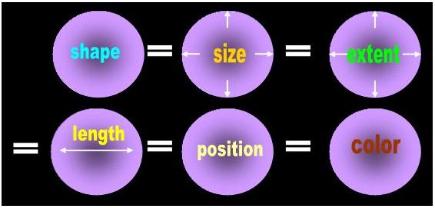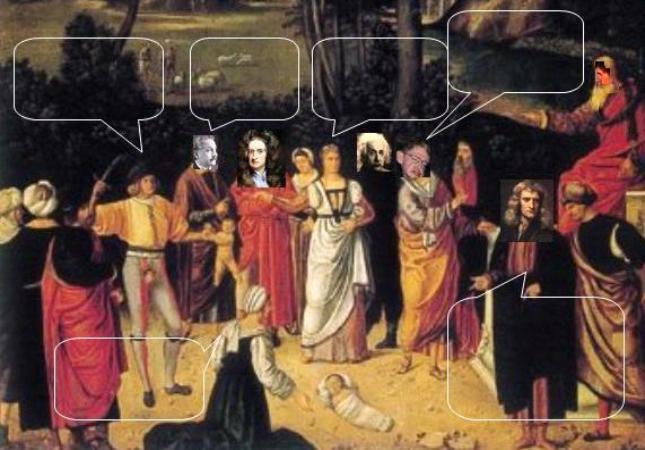| Adapted for the Internet from: Why God Doesn't Exist |
1.0 So what’s new?
The seasoned philosophers will say that all I have done is restrict the word object to those things that have form.
Yes! I confirm. That’s what I am proposing.
But then they’ll say that they’ve known this argument for thousands of years. They already regarded shape and form as
attributes of objects, together with color and smell and position. These issues have been debated ad nauseam. This is
nothing new.
Wrong!
What is new is to realize that only this property known as shape or form has anything to do with the object proper and
with Science. The remaining attributes (unity, color, size, etc.) have to do with concepts and are circumscribed to ordinary
speech. Objects are what you point to and name. This is the only thing that the ET sees so far. Anything beyond this treats
an object as a category (i.e., a concept, a relation, the subject of a sentence, a term, a noun, etc.). Nevertheless, a table is
an object before you point and name it. It is so because it has shape and not because it has color or size. These other
attributes require an observer.
What is new is that we are no longer going to confuse objects with concepts and chase our tails around in circles during
discussions like Plato, Aristotle, and all of their successors.
What is new is that now we are aware of why the objecthood debate has gone on for so long. Shape synthesizes the
notion of Oneness that philosophers have always talked about. When we talk of shape, we are not analyzing the thing
into its constituent parts. Shape is an attribute taken all by itself.
What is new is the realization that only this version of the word object can be used consistently in a scientific presentation.
We certainly cannot use the word object consistently if we say that the object itself is made of more objects. This guarantees
circularity.
What is new is that this definition does away with the ‘see/touch’ proof definition used by everyone and their mothers. The
Moon has shape irrespective of observers. The Moon does not spontaneously blend with space when you turn around.
The Moon does not have shape only when we are looking at it as the morons who believe in the ridiculous
Uncertainty Principle hold. The Moon was there before anyone on this planet came aboard. The Moon is not yellow as a
result that this is the color that reaches the observer’s eyes. And it is not yellow intrinsically because the frequency the
Moon’s surface irradiates does not define the object Moon. The only attribute that Father Universe recognizes in the
Moon is its shape. By itself, the Moon is neither big, nor yellow, nor has location. Such attributes require external
references. Shape requires space, but space is not an object. There is no relation taking place because there are no
observers. The Moon simply refuses to blend and become one with space irrespective of observers. It doesn’t even try.
They are by their very nature incompatible. Therefore, unlike color, size, location, etc., shape is a de facto attribute. What
is new, in other words, is that we have finally rid ourselves of the damned observer so necessary to the mathematical
and traditional religions of the world.
What is new is that no one ever realized the importance of the word object to science and to Physics in particular. In fact,
although they recorded similar definitions of ‘thing’ to the one I am proposing, Aristotle and Euclid never used the ‘shape’
notion of object in their arguments. Not a single geometric figure that they defined invokes this attribute. Hence, they
never understood the significance of shape and boundaries. They were almost totally absorbed and fascinated by
quantitative relations. Like the mathematicians of today, the Greeks dealt totally with abstractions throughout their
dissertations.
What is new is that relativists and mechanics will now have to produce shapes and not attempt to bluff their way with
abstract concepts. Either a point has shape (dot) or it doesn’t (location/ordered pair/event) And either a black hole has
shape and is an object or it doesn't have shape and is a concept. And either the space-time sphere is 3-D or 4-D. It is
the object-concept duality that mathematicians and philosophers thrive on that perpetuates needless discussions.
The restriction I now place on the word object will differentiate science from religion. Unless there is an explicit or an
implicit shape at the Exhibits phase of the presentation, the presenter is not doing Science.
2.0 Other objections
The philosophers may try to raise a few semantic and epistemological objections. Doesn’t an object also have size,
length, and extension? Doesn’t an object occupy a position? What about the word ‘that’ in the definition. Doesn’t this
word already insinuate that we’re talking about an object? Or maybe we should just leave the term object undefined
or define it as the opposite of nothing?
Let’s annihilate these ridiculous objections with quantum-like anti-objections so that they don’t haunt us further down
the road. This will introduce us to more subtle, deeper arguments.
a. Size
Qualifiers such as size, length, extent, and position are very tricky. A man measures 1.8 meters. We say that this is his
size, length, or extent. We determined this by comparing him against another object, perhaps a measuring tape. Hence,
the inclusion of these properties would make the definition of object circular. We would need one object (our pre-defined
standard) to determine the size, length, or extent of another.
But let’s bypass Mathematics and measurement altogether and not bring them into the discussion at all. The skeptic may
argue that an object has shape because it is qualitatively greater than nothing, meaning more than emptiness, meaning
infinitesimal. This is why we refer to it as something instead of as nothing. The question now is whether we have stated
anything other than shape. In this context size, length, and extent are synonyms of form. What else can these parameters
mean outside of mathematical magnitude? Surely, we are not comparing the size or length of the object against anything
else. We are just saying that it is more than nothing in extent, or in the alternative, that space is discontinuous in that
region. Matter has interrupted the continuity of space so to speak. Whether malleable like a piece of clay or inflatable like
a latex balloon, an object has size, length, and extent for only a cross-section of time. At that precise location, qualitative
size, length, extension, and position are synonyms of shape (Fig. 1).
- “ Extension in length, breadth, and thickness constitutes the nature of corporeal
substance …Everything else that can be ascribed to a body presupposes
extension.” [1] [2]
- How about qualifiers such as continuous or white?
- Again, before we can understand continuous we must compare it against discrete and before we can understand white
we must understand what a wavelength is. The problem with qualifiers such as continuous and white is that they are
related to observers and not to what objects are in and of themselves. A swan is an object because it has shape and
not because it is either white or continuous. Shape is a special type of qualifier or property in the sense that it really has
no opposite at this level. Shape has an opposite in or contrasts with ‘no shape’ whereas object is a category that only
includes ‘that which has shape.’
| the philosophers voice their objections |
b. That and Has
The philosopher may now get picky and say that the word ‘that’ in ‘that which has shape’ converts the definition to a tautology.
The word 'that' serves as a wild card in the definition of object. It functions as anything that we can name and that can serve as
the subject of a sentence (i.e., a noun, a term). The word object itself, as we will see, is a category and therefore a concept. This
has nothing to do with the word table which is classified as an object. by virtue of its shape. The word ‘that’ momentarily serves
as a placeholder for the word under scrutiny. The words something, thing, and body are much more ambiguous. Something
already insinuates a substance.
The word has may also lead some philosophers to infer that shape is an extrinsic property (e.g., I have a penny). Should we
accept the foregoing proposal, so the argument would go, shape could just as well be a property of the medium that contours
our test object. By invoking this medium, the definition is just as circular as the ones I criticized. Isn’t a perimeter, after all, an
interface between two objects?
The short answer is no. Here I give this matter a more thorough treatment.
- c. Nothing
To say that something is the opposite of nothing is not too much of a problem as long as the proponent can define the word
nothing in turn without saying that it is the opposite of something. Nevertheless, a horse, love, energy, the number 5, and
space-time would all equally qualify as ‘not a nothing’ and, surely, few will defend the argument that the number 5 is
qualitatively identical to the word horse. Like a synonym, an antonym is ‘nothing’ but a circular definition.
- d. Primitive
Relativists find nothing more useful than leaving key words undefined, particularly those necessary to understand their
theories. The words that have been left to float around are the ones that form the basis of Geometry: point, line, plane, and
solid. Since relativity claims to be founded upon Geometry, all of relativity sits on quicksand.
The mathematicians defend themselves by arguing that some words are impossible to define precisely and, therefore, must
remain ‘primitive.’ The term 'primitive' refers to a word that is ‘useful’ despite that the mathematicians are incapable of defining
it in simpler terms. This sleight of hand enables prosecutors to delegate the task of interpreting a hypothesis to the jury rather
than assuming the responsibility of formulating and visualizing it themselves first. The tactic consists of apologizing to the
jury beforehand and declaring that the mathematicians did everything they could to define a word, that they brainstormed
every possibility, but still came up short:
- “ in pushing our researches further and further, we arrive necessarily at primitive
words which can no longer be defined” [3]
[Necessarily? I wonder why this must be so?]
Such straight-forward candidness and honesty buys them heart-felt sorrow and a strategic reprieve, which they subsequently
use to their advantage during trial. They now have a green light to claim that space-time is an object, or that a black hole is an
object, or that a point particle is an object, and no one can challenge them because the crucial word ‘object’ slipped through
unchallenged. You know. It is one of those whachmacallit... primitive words.
Actually, when the mathematicians gloss over the definition of ‘useful’ words such as object or exist, the theory that follows is
not beautiful, as they like to boast in their immense ignorance, but either unintelligible or fantastic. A theory founded on strategic
primitive words or dualities is simply unscientific. We can explain everything and anything with words that we don’t have to
define. Is space-time an object?
- “ We must accept that time is not completely separate from and independent of space,
but is combined with it to form an object called space-time.” [4]
Well, as long as we don’t have to define the word object, then yes, maybe it is. Or perhaps space-time is just:
• a concept:
- “ in the general theory of relativity the space-time-concept refers to the behaviour of
rigid bodies and clocks.” [5]
• an ‘object-concept’
- “ Let us call the concept or category in question the object-concept, and the thesis of
its universal applicability the object-thesis. Philosophical uses or senses of ‘object’
less comprehensive than this are sometimes sponsored—Frege, most notably,
proposes an absolute if puzzling contrast of object with concept or property—but
we are here concerned exclusively with the object-concept in its unrestricted sense.” [6]
• a ‘mathematical object.’
- “ Space-time, as you might recall, is that almost magical 4-dimensional arena in which
time and 3-dimensional space are considered as a whole; a single mathematical
object.” [7]
Who knows? In relativity, you can invent your own definitions if you want because no one is allowed to challenge the definition.
That activity belongs in Philosophy, not in Mathematics. You can say that space-time is caca and tell the mathematician that
Einstein said so, and he’ll believe you. Laxity is the cause of explain-it-all words such as soul, love, and God. If traditional
religion teaches us anything, it is that ‘usefulness’ is an incorrect criterion, in fact the worst one, for tolerating a word during
a presentation.
The definition of object that I propose closes these loopholes. If we pin the word object down to shape, not a single equation
can save our mathematicians. I don’t do this to give relativists a hard time. I do it in order to use the words consistently and to
compel the mathematicians to tell the jury what they really mean. I am trying to bring a little bit of logic to the discussion by
circumscribing the use of strategic words. Don’t relativists claim that the Universe in which we live is a globular ‘thing’?
Don’t relativists talk about the large-scale structure of the Universe? Don’t they speculate on whether our cosmos is closed,
open, or hyperbolic? Don’t they also claim that a black hole is an object? Don’t the mechanics claim that they accelerate tiny
objects called particles? What is the point of all these claims if the mathematicians never have to specify what they mean by
object?
Of course, if relativists prefer not to define the word object, they should not be allowed to use this heretofore ‘useful’ term in
their theories. They should not be allowed to illustrate space-time or a black hole until they tell the layman what they mean
by object. As soon as a relativist puts pen to the paper, we should stop and ask whether the illustration in progress will
depict the actual shape of space-time, black hole, or particle. If not, why bother? If this hypothesis is admittedly in
disagreement with the theory that follows, what is the purpose of the illustration? The surrealistic religion of mathematical
physics finds its most formidable foe in the definition of the word object!
Before I can address further objections and counterclaims, it is necessary to establish a clear difference between an
object and a concept and between real and abstract objects. Only then can we understand how to use these words
consistently in a scientific setting. Afterwards, I will use these definitions to resolve the difficult cases of objecthood
(shadow, hole, air, wind, etc.).

Fig. 1 |
| The only property a stand-alone object has on its own, independent of observers, is shape. In a single-object universe, para-meters such as length, size, volume, position, etc., are synonymous with shape because, assuming we now add an observer, he has nothing against which to compare these parameters. |

| A baby is an object because I can cut it in half. |
| It’s not a baby. It’s a boy. |
| It’s human because it has size. |
| It is not human because it doesn’t cry. |
| If this is a baby, it is quite primitive. |
| A baby is something because it is the opposite of nothing. |

| Okay, folks! FOLKS! I’ll side with the guy at the far end. Let’s see if we can cut it in half. Then we'll know for sure whether it was a thing. |
- Module main page: After 3000 years, the idiots of Philosophy cannot tell you what an object is!
Pages in this module:
1. The ultimate subject matter of a scientific dissertation must be a physical object
2. Is an object a bundle of properties?
3. Is an object a substance?
4. What really is an object?
5. This page: The philosophers voice their objections
- ________________________________________________________________________________________
- Copyright © by Nila Gaede 2008
